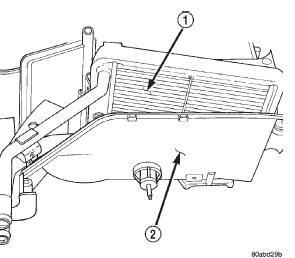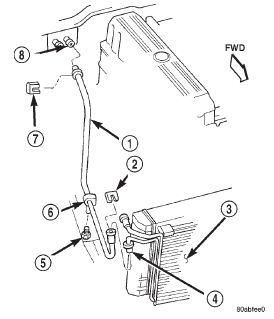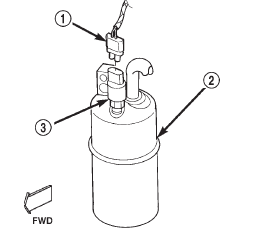Jeep Cherokee (XJ): Heater core. Liquid line. Low pressure cycling clutch switch
WARNING: ON VEHICLES EQUIPPED WITH AIRBAGS,
REFER TO GROUP 8M - PASSIVE
RESTRAINT SYSTEMS BEFORE ATTEMPTING ANY
STEERING WHEEL, STEERING COLUMN, OR
INSTRUMENT PANEL COMPONENT DIAGNOSIS OR
SERVICE. FAILURE TO TAKE THE PROPER PRECAUTIONS
COULD RESULT IN ACCIDENTAL AIRBAG
DEPLOYMENT AND POSSIBLE PERSONAL
INJURY.
(1) Remove and disassemble the heater-A/C housing.
See Heater-A/C Housing in this group for the
procedures.
(2) Lift the heater core out of the lower half of the
heater-A/C housing (Fig. 48).
(3) Reverse the removal procedures to install. Be
certain that the heater core foam insulator is reinstalled. Any kinks or sharp bends in the refrigerant plumbing
will reduce the capacity of the entire air conditioning
system. Kinks and sharp bends reduce the
flow of refrigerant in the system. A good rule for the
flexible hose refrigerant lines is to keep the radius of
all bends at least ten times the diameter of the hose.
In addition, the flexible hose refrigerant lines should
be routed so they are at least 80 millimeters (3
inches) from the exhaust manifold.
High pressures are produced in the refrigerant system
when the air conditioning compressor is operating.
Extreme care must be exercised to make sure
that each of the refrigerant system connections is
pressure-tight and leak free. It is a good practice to
inspect all flexible hose refrigerant lines at least once
a year to make sure they are in good condition and
properly routed.
1 - HEATER CORE WARNING: REVIEW THE WARNINGS AND CAUTIONS
IN THE FRONT OF THIS GROUP BEFORE
PERFORMING THE FOLLOWING OPERATION. REMOVAL (1) Disconnect and isolate the battery negative
cable.
(2) Recover the refrigerant from the refrigerant
system. See Refrigerant Recovery in this group for
the procedures.
(3) Disconnect the liquid line refrigerant line couplers
at the evaporator inlet and the condenser outlet
(Fig. 49). See Refrigerant Line Coupler in this group
for the procedures. Install plugs in, or tape over all of
the opened refrigerant line fittings.
(4) Remove the liquid line from the vehicle. INSTALLATION (1) Remove the tape or plugs from the refrigerant
line fittings on the liquid line, the evaporator inlet
and the condenser outlet. Connect the liquid line to
the evaporator inlet and condenser outlet refrigerant
line couplers. See Refrigerant Line Coupler in this
group for the procedures.
(2) Connect the battery negative cable.
1 - LIQUID LINE WITH ORIFICE TUBE (3) Evacuate the refrigerant system. See Refrigerant
System Evacuate in this group for the procedures.
(4) Charge the refrigerant system. See Refrigerant
System Charge in this group for the procedures. REMOVAL (1) Disconnect and isolate the battery negative
cable.
(2) Unplug the wire harness connector from the
low pressure cycling clutch switch on the top of the
accumulator (Fig. 50).
(3) Unscrew the low pressure cycling clutch switch
from the fitting on the top of the accumulator.
(4) Remove the O-ring seal from the accumulator
fitting and discard. INSTALLATION (1) Lubricate a new O-ring seal with clean refrigerant
oil and install it on the accumulator fitting.
Use only the specified O-rings as they are made of a
special material for the R-134a system. Use only
refrigerant oil of the type recommended for the compressor
in the vehicle.
1 - WIRE HARNESS CONNECTOR (2) Install and tighten the low pressure cycling
clutch switch on the accumulator fitting. The switch
should be hand-tightened onto the accumulator fitting.
(3) Plug the wire harness connector into the low
pressure cycling clutch switch.
(4) Connect the battery negative cable.Heater core
Liquid line

Fig. 48 Heater Core Remove/Install
2 - LOWER HEATER-A/C HOUSING
Fig. 49 Liquid Line Remove/Install
2 - CLIP
3 - CONDENSER
4 - OUTLET TUBE
5 - STUD
6 - CLIP
7 - CLIP
8 - EVAPORATOR INLETLow pressure cycling clutch switch

Fig. 50 Low Pressure Cycling Clutch Switch Remove/Install - Typical
2 - ACCUMULATOR
3 - LOW PRESSURE CYCLING CLUTCH SWITCH
 Kick cover. Mode door vacuum actuator. Refrigerant line coupler
Kick cover. Mode door vacuum actuator. Refrigerant line coupler
Other materials:
Lamp diagnosis
DIAGNOSIS AND TESTINGDiagnostic procedures
When a vehicle experiences problems with the
headlamp system, verify the condition of the battery
connections, fuses, charging system, headlamp bulbs,
wire connectors, relay, high beam switch, dimmer
switch, and headlamp switch. Refer to Group 8W,
Wiri ...

